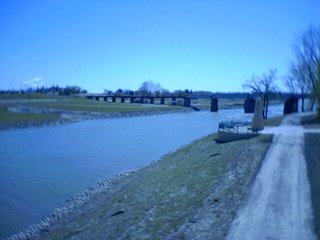Red River of the North
|
|
- For other things named Red River, see the Red River disambiguation page.
The Red River, one of several by that name, is a North American river. It flows northward through the Red River Valley, forming much of the border between the U.S. states Minnesota and North Dakota, and then flowing into Manitoba, Canada. Measured from the Sheyenne River, it is 877 km long, falling 70 m on its trip towards Lake Winnipeg, spreading into the vast deltaic wetland known as Netley Marsh. It was a key river in the early settlement of Canada, notably being home to the Red River Colony that later became Winnipeg.
In the United States it is called the Red River of the North, to distinguish it from another Red River (a tributary of the Mississippi River that forms part of the border between Texas and Oklahoma).
It is formed at Wahpeton, North Dakota and Breckenridge, Minnesota by the confluence of the Bois de Sioux and Otter Rail rivers.
The Red River passes Fargo, North Dakota, Moorhead, Minnesota and Grand Forks, North Dakota, East Grand Forks, Minnesota, then enters the province of Manitoba in Canada. That province's capital, Winnipeg, is at its confluence with the Assiniboine River. The river drains into Lake Winnipeg and is part of the Hudson Bay watershed.
The Red River flows across the flat, former bottom of the ancient glacial Lake Agassiz.
The Red River famously flooded in April 1997, causing $2 billion USD in damage to Grand Forks, North Dakota. Winnipeg, though downstream, suffered only $51 million CDN in damage, because the city is protected by the Red River Floodway which diverted most of the water around it. Other major floods occurred in 1826 and 1950.
See also
- Red River Basin
- Red River Settlement
- List of Manitoba rivers
- List of Minnesota rivers
- List of North Dakota rivers
External links
- Canadian Council for Geographic Education page with a series of articles on the history of the Red River (http://www.ccge.org/ccge/english/Resources/rivers/tr_rivers_redRiver.asp).
- Geological Survey of Canada page describing the nature and history of Red River floods (http://gsc.nrcan.gc.ca/floods/redriver/index_e.php).

